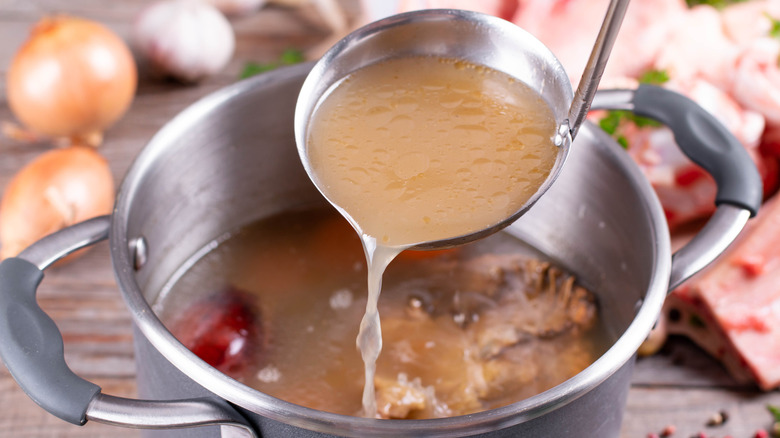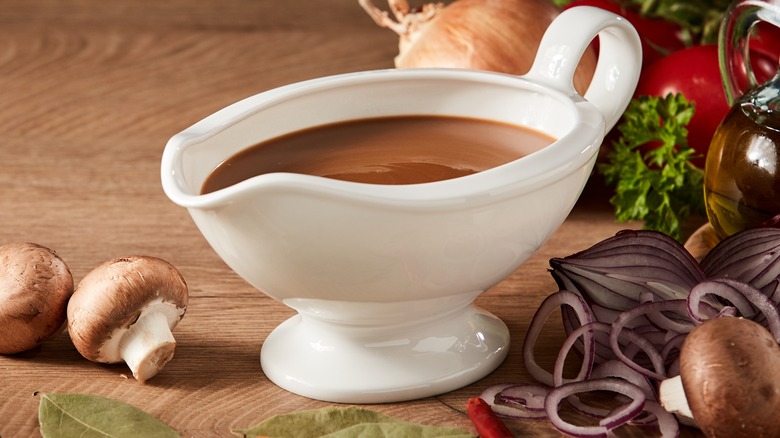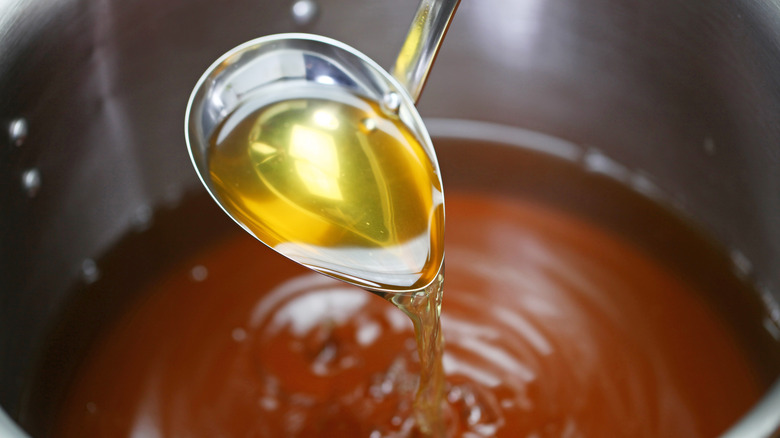The Only 2 Items You Need To Quickly Skim Fat From Liquids
Let's say you're making a very simple turkey stock. There's nothing too complex or weird in there — just some broth, a few aromatic vegetables like onions, celery, and carrots, and maybe even a few turkey bones you had left over from a previous turkey dinner. Before you add the noodles in, however, you'll notice there's a "foam" bubbling on top of the surface of the broth, resembling something like the scum you'd see on the surface of a pond. Where did this weird "foamy scum" come from, since everything in the pot is either meat or vegetables.
This "scum" on the top of your stock is, according to Drexel University food science professor Rosemary Trout to Bon Appetit, nothing more than "coagulated proteins" that form air pockets during the boiling process. These proteins usually happen during the boiling of meat-based broths or soups — like chicken stock, for example — or liquids that have chickpeas, lentils, or other protein-rich vegetables. Basically, this foam is nothing more than fats and other "impurities" that rise to the surface of the stock as it sits. The same thing happens if you're making gravy and notice that you're getting a fatty, greasy layer on top of it.
While this fatty foam isn't anything dangerous and causes no harm if ingested, you'll still want to remove it from your stocks and gravies. Fortunately, all you need is a cheesecloth and some ice to take care of this problem quickly and easily
Wrap the ice in the cheesecloth to solidify the fatty layer
At first glance, the idea of using ice seems to go against what you're trying to do. You want to remove that layer of grease and fat from your stock, not try to water it down. While adding ice to your stocks or gravy base wouldn't be recommended at any other time, this method actually helps to remove that layer of clumped fat very easily.
Take a handful of ice cubes — depending on how much liquid you have, you may want to add more or use less ice — and then wrap it in the cheesecloth, sealing the bundle of ice with a string. Take the cheesecloth and dunk it into your pot of stock or gravy boat. Let the cloth sit in the liquid for a few minutes before removing it. The ice should have caused this layer of fat to solidify and congeal, sticking to the bag of ice as you pull it out.
If you're worried about dunking ice into your stock for fear it may water it down, you can achieve the same result of solidifying the fat by placing your stock or gravy in the fridge for a few hours. The layer of fat will harden into a single cohesive layer, which will float on top of the stock. You could then easily remove this layer by breaking it apart or, if you're particularly skilled, using a ladle to nudge it loose in one piece.
You can also use a turkey baster to siphon the stock
If you don't want to risk watering down your stock and don't have the time to put it in the fridge, what do you do? Another good solution involves a turkey baster siphoning off not the fat, but the actual stock underneath it.
To do this method, take a turkey baster of your choice and lower it into the pot or cooking vessel while squeezing the bulb. Don't just dip it into the stock, but make sure to submerge it fully into the stock until the tip reaches the bottom. When you release the bulb, you'll suck up the liquid underneath the fatty layer. You may have to do this two or three times until all of the liquid is removed. Once you're done, you can empty the baster into another clean bowl or pot and then discard the fat as you usually would.
This method is not only quick, but it also makes sure that the stock you're using is clean and free from any fat rather than just scooping chunks of semi-solid fat from the top of it. It's worth noting, however, that this method is best used for liquids instead of chunky soups as, while you managed to get the liquid itself out, you'll have the meats and vegetables left in the pot with the fat. Whether you freeze it or drain it, skimming fat from your soup or gravy can be done quickly and easily.


